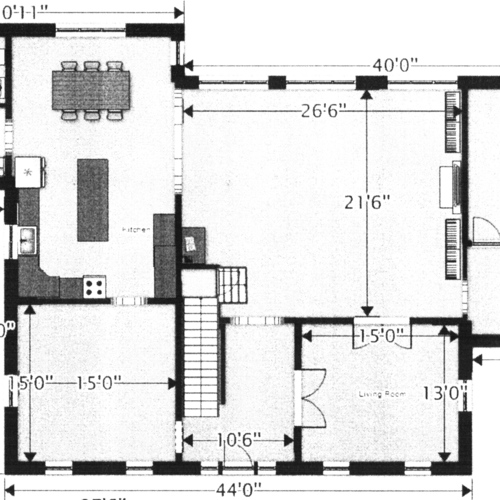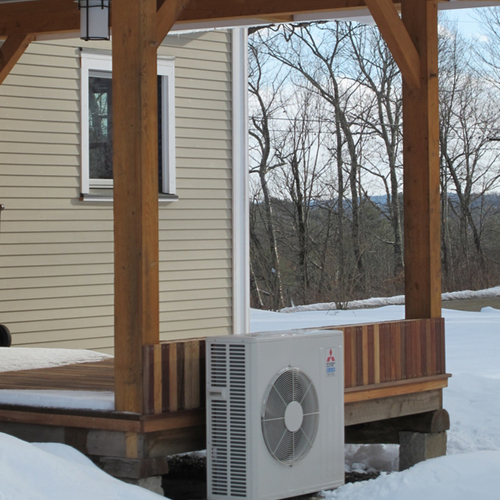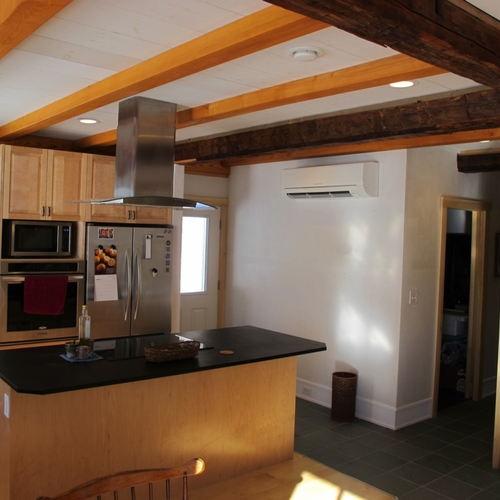
In order to understand what causes homeowners to complain about indoor temperatures, and then determine how to troubleshoot the issues, we need to think about a few important ways ductless heat pumps differ from the central heating systems—furnaces, boilers, and ducted heat pumps—that most customers have. I’m writing as a practitioner in Upstate NY, climate zones 5 and 6, where the vast majority of temperature control issues we have with ductless systems are in heating mode. While we do have a significant demand for summer cooling and dehumidification, most of the complaints I’ve handled relate to heating. Some of the reasons for that will become apparent below.
Some of the most common complaints about ductless heat pumps involve temperature control. A few examples include:
“I set the remote control to 72°F but the thermometer on my coffee table never gets above 67°F.”
“The head in my bedroom overheats the room. Even when I turn it off, I can still feel heat coming out of it.”
“Sometimes my heat pump starts blowing cool air, even when I have it set to heat.”
“I feel like this thing has a mind of its own.”
Sensor location
Central heating systems are generally controlled by thermostats located on interior walls, 3-1/2 to 5 ft. off the ground, and away from direct sunlight and heat sources such as appliances and forced-air registers. Temperature at the thermostat serves as a pretty good proxy for the temperatures experienced by occupants. Most ductless heat pumps, on the other hand, sense temperature with a thermistor located on the ductless head itself. (While the default wireless remote control can be used to adjust set points and other settings, it does not provide temperature feedback). For the most common style of head, the “high wall” unit, this places the…
Weekly Newsletter
Get building science and energy efficiency advice, plus special offers, in your inbox.

This article is only available to GBA Prime Members
Sign up for a free trial and get instant access to this article as well as GBA’s complete library of premium articles and construction details.
Start Free TrialAlready a member? Log in















18 Comments
The ceiling fan did the trick for me. Depending on how cold it was, I had to increase the set point temperature by two or four degrees to get the desired temperature of 68F. I added a energy star ceiling fan, put it winter operation on low (3 watt consumption), and now have the set point match the desired room temperature. The other added benefit I noticed is that the ceiling fan reduced short cycling of the minisplit. The down side of running the ceiling fan if you so will, is that I have to clean the minisplit filter screen more often. Low energy 1500 sf home in Chicago, ACH50 = 0.7. 12,000 BTU Fujitsu ductsless.
That's an interesting observation about the filter screen. Also, it sounds like a great example of how far you can downsize the HVAC, even in a cold climate, if the building shell is tight and well-insulated.
I have a Nest gen 3 thermostat that I like. The heat source is a natural gas wall furnace. I plan to switch to a Mitsubishi mini split in the near future. Is it possible to hook up the Nest to the Mitsubishi?
Yes. You will need a interface adapter from Mitsubishi, and you'll also need to run thermostat wire to the ductless head.
I'm not familiar with Nest Gen3. But when I checked on this with a tech support guru a couple of years ago I was advised you can pair a Nest with a mitsubishi heat pump but that you probably shouldn't.
As I understand it the Nest was designed to wring additional efficiency out of combustion devices that are typically bang-on bang-off or modulating in a limited way at best. So the thermostat can "learn" your habits and make subtle energy saving modifications that you don't notice.
Air source heat pumps like Mitsubishi hyperheats are much more sophisticated, and the Nest is not made for that, so I was warned that a Nest is likely to degrade the unit's efficiency rather than optimize it.
I highly recommend Mitsubishi's mhk2 control.
Good to know. I like being able to turn off or on w/ a phone when not at home. Also up or down. Will the mhk2 do this? You can disable the learning function on the nest easily. You can also control the spread between the heat on and heat off.
The mhk2 is a wireless wall mount thermostat. For wifi you'd need the PAC-USWHS002-WF-2 adapter. Not as many bells and whistles as the Nest and it can be finicky to set up.
Would love to hear your take on all these issues when applied to a super-efficient Passivehouse level home. Which issues get better and which get worse? I'm having a hard time coming up with a design since the max room loads are less than the lowest heads' output, and nothing modulates low enough for typical loads let alone shoulder season loads. Have you heard of anyone coming out with 3-4k heads? Even 6k's are rare, and the small outdoor units max out at 2 heads each.
We've had good luck with the mitsu fh06 (now fs06) or 09 depending on load, operating in conjunction with a Zehnder ERV. A single heat pump head can serve the whole house because the ventilation system evens out temperature differences between rooms, so a compartmentalized space behaves like a single space. Because super insulated very tight buildings gain and lose heat very slowly, the heat pump is able to tick along the way it likes to, and the turn down ratios are enough to avoid short cycling even if your design load comes in lower than the equipment capacity. Also, there are some control options that will help with short cycling--for example increasing the dead band a degree or two.
Thanks. I was wondering if the Zehnder would do that and would love to hear for details. What room are you putting it in, Living Room? Are these single or multi story homes, and appr size? What climate zone are you? I'm in 6 and not quite PH for 6, so while my average winter loads are 10k BTU for the house, my max design load is 40k, so sizing for peak loads worries me it won't modulate low enough for low loads.
These blogs by John Harrod are really excellent..
I agree, Malcolm. I am very pleased to have him as a regular contributor.
I'm zone 6 as well.
1200-2600 ft2 typically. One head in the living room works well for single storey. On a larger two story the load won't justify two, but one up and one down allows a bit of zoning and redundancy.
40kbtu is significantly higher than our typical range on a passive project. I'd think you'd be fine with two mitsu fs 18s. You can program thermostats to minimize short cycling or turn one off completely in shoulder seasons. Install a sense energy monitor and you'll be able to see how they operate.
You can shave peak load from your heat pump by installing electric resistance as well. It might only operate a couple of days out of the year and allow you to go with smaller equipment and a better turndown.
(Sorry, that was posted as a reply to #11, not sure why it didn't go there.)
Norman, Thanks for these comments they are extremely helpful. I've been wondering for a while how well an ERV will help with conditioned air distribution. I would love to avoid installing a ducted system or an air handler to distribute to different bedrooms. No issues there on your end?
I have had very similar experiences in my recent set of forays into multi-zone mini split design with our panelized homes. I've learned to be very careful with the Mitsubishi remote control because it will turn on the i-see function whenever the battery has to get replaced, unbeknownst to the homeowner. I have especially learned to have the conversation early on with customers, as you suggest, about the different experience you might have with a heat pump in a high performance home compared to another source of heat in a "normal" home. I used to be cocky enough to specify mini splits if the homeowner seemed interested in efficiency...I don't do that anymore, I now require that customers hear my mini split pro/con spheel before they agree to them. I've also learned that there's a certain type of customer who just is not a good fit for mini splits, and that would be a customer that wants to be able to turn the temperature up and feel extra heat quickly, is not interested in high tech, and is really bothered if, for example, their own thermostat that they buy says 70 while the Mitsubishi thermostat says 72.
The air velocity chart for the Mitsubishi FS12 wall unit was a great addition to this article. I’m planning to have Mitsubishi ductless units installed in the 2nd floor of my cape style house. There is only one location in each room where a high wall unit will fit, and that would also be above the head of a bed. Is that arrangement always a bad idea? Or do some units, like the FS06, have a setting that could allow for comfort in all operation modes?
Some installers recommend the low wall unit as a way to avoid air being blown on the bed. The challenge with these is the limitation in furniture placement.
Being in Southern California you can imagine that I would mostly have a cooling problem. I do. I have a Mitsubishi installed with approx 6” of space between the top of the unit and the ceiling and below the unit is a door to outside which is well insulated. Ceilings are 10 ft. I’m also using Kumo Cloud, I can see that the sensor temp in the head is saying it’s 80 degrees or so while the settings are at 77 for cooling and the actual temp in the room is 72. Cost is not a problem for this room but do the wifi thermostats that you can add (wired to the to the head and on the wall below) actually provide the temp sensing that the head sensor does? Does the thermostat replace the function of the head temp sensor? Since I have a Mitsubishi unit, what Wi-Fi smart thermostat would be best and where would be instructions on how to wire it to the head?
Log in or become a member to post a comment.
Sign up Log in